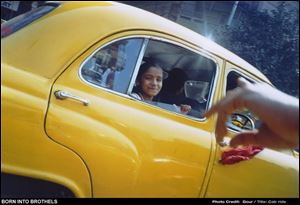
Movie review: Born into Brothels ****
3/18/2005
Cab Ride is the title of a photo taken by 13-year-old Gour, one of eight children befriended by Born into Brothels director Zana Briski. The film won the Oscar for best documentary.
One does what one can.
Zana Briski does more. It's not enough. She is an American photographer with the instincts and worn soles of a reporter. In 1998, she moved into an apartment in the red-light district of Calcutta, a neighborhood where one finds infants chained to poles. Squalor here is like a birthright.
Briski intended to document the prostitutes, who seem to crowd every alley and doorway. It's called standing "on the line," and for women at least (male prostitution undoubtedly exists, but is far less obvious), the fate is inescapable. Briski finds generations of women, often within the same family, engaged in prostitution.
Briski is tall. She stands out more than she probably wants. She has a craning neck and a sympathetic face, and there's an earnestness about her that must look routine to these residents, who know a thing or two about well-meaning outsiders showing up to document their poverty.
A few suspect she works for the Indian police. When her camera comes out, evidence slides away, doors shut, windows slam down. But the children of these prostitutes, curious and full of beans, linger behind. They follow her.
Briski has a stroke of genius.
On a whim, she buys cameras and a mountain of film, and hands them to eight children she's befriended. For starters, there's the timid Kochi and the jostling Manik, and while she barely knows them, she asks if they'd like to learn photography. She starts a class, gets their parents' permission, and hands out equipment. She has one instruction:
Photograph your world.
The startling, moving, surprisingly often funny account of what the red-light kids came up with is Born Into Brothels, which opens today in Toledo after making art-house rounds for a couple of months. It was directed by Briski (who also narrates) with co-director Ross Kauffman, and last month the film won the best documentary Academy Award.
But then, of course it did.
If your experience with documentaries is limited to clips on Oscar night, you'd understandably think best documentary typically goes to a subject of crushingly depressive weight - and you wouldn't be entirely wrong. It is hard to imagine a setting more hopeless than the one found here. At a glance, it'd be understandable if you lumped this in as just another periodic, well-meaning consideration of poverty - held at arm's length.
A recent cover of Time had a black-and-white photo of a starving person and the headline "How to End Poverty," part of an excerpt from Jeffrey D. Sach's book The End of Poverty. And even then, the impact on us remains tiny.
It's easy to be cynical about a film like Born Into Brothels or a bold headline, and we know the reason: Well-meaning people rarely make lasting impressions. And almost never make art. The instinct is to go for tears or shame, and the song remains the same. Briski is more pragmatic.
Born Into Brothels doesn't pussy-foot around the circumstances. Briski faces the situation honestly. There is only so much art can do; just as there is only so much one person can accomplish against the inertia and oppression built up in a place over not years or decades, but centuries. And the red-light district of Calcutta will likely remain a dead end of horrifying squalor for centuries to come.
Briski smartly avoids making overarching statements about third-world poverty, and doesn't muddle her portrait with obvious comparisons between the Indian middle class and these people, who seem to need 946 pieces of paper stamped by 947 different bureaucrats before they're granted the "required papers" needed to travel, attend a boarding school, or do anything.
Instead, the kids become kind of collaborators, and if the film works, that's because Briski focuses squarely on them. We meet each, and watch them wander around with the cameras. They discover that by framing their worlds, they gain a little understanding of it. One of the joys here is to watch their faces open up as they realize how an old place seems new, and later, when Briski brings their photos to a Manhattan art exhibit, they watch a videotape of the event, and you can see a light bulb going on. Their life has expanded.
One chunky boy, Avijit, midway through the film, loses his mother in a fire. His father is drunk a lot. "But even then," he says. "I try to love him a little."
So Briski decides to use the sale of the pictures to raise money to send the kids to a boarding school. What's remarkable is how seriously they take the photography, but also how accomplished the pictures are. One boy may take his photos at night with no flash. Others discover the way art exists in the lowliest of circumstances. There's some suspense in the outcome, until you realize the outcome is predictable. Though not entirely.
Avijit's pictures are extraordinary, the elegant, inventively composed works of a boy of such natural skill, he becomes the talk of an international competition. Is Briski exploiting these kids, you wonder. Perhaps. She gets a film out of it. But by granting eight children a bit of dignity, they're noticed as more than a statistic. And maybe shown an exit. Avijit walks back to his slum after a day of shooting. A prostitute grabs his arm and he shakes it off. A tree grows in Calcutta.
Contact Christopher Borrelli at: cborrelli@theblade.com
or 419-724-6117.